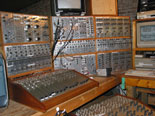Data sheet (Event):
| Digital Chile_08 | |
| Title of event Digital Chile_08 | |
| Start date 2008-02-21 |
End date 2008-03-23 |
| Event location Society for Arts and Technologies (SAT) Gallery, Montreal, QC | |
| Type of event Exposition |
Participation method Analyse |
| Theme 1- Conservation of media art | |
Observer: Paulina Mickiewicz |
|
Having opened within the context of the Montreal High Lights Festival, Digital Chile_08 was launched at the Society of Arts and Technology (SAT) Gallery as the gallery’s third international exhibition since its opening. The exhibit features the avant-garde works of Yto Aranda (Cyber Birds Dance), Klaudia Kemper (Body Project), Alberto Lagos (Panorganic Vision), Roberto Larraguibel (Equilibrium Explorer), Felix Lazo (Like A Second Nature) and Claudio Rivera-Seguel (Publik-O); all multidisciplinary artists from Chile. According to SAT this event “aims to show Chilean avant-garde art in Canada, in order to generate a comparison, debate and analysis regarding the differences and similarities of the formal and thematic content between artistic productions of both countries.” The exhibit consisted of a single work by each aforementioned artist and the various media used ranged from digital photography to web-art and video immersive installations. Depending on the artwork the viewer was often invited to engage with the art itself. Yto Aranda’s Cyber Birds Dance for example, is a web-art installation in which the viewer is invited to click on the image of a bird on a computer screen which sets off the creation of various images of more birds, seemingly to question how we experience nature in our technological age, in reality or through a screen. As described (above) by SAT itself, the goal of the event seemed to be to establish as well as strengthen communication between the New Media art worlds of Chile and Canada. The concentration seemed to be more on experimentation of the forms and themes of the artworks themselves rather than on the documentation and preservation of these artworks. In fact preservation of the art did not seem to be considered at all. I was particularly struck by Klaudia Kemper’s Body Project which seemed to be in the process of deterioration within the exhibit itself. To describe the artwork I borrow once again from SAT’s description: “This is a video installation on non-conventional screen format. Four DVD loop projections over 100 balloons, which conform an organic structure in the middle of a room in complete darkness, takes us into an altered reality. The projections, divided into 36 and 129 frames, show us fragmented pieces of human bodies in movement. The soundtrack was created from the sounds made by the bodies, which emphasizes the organic feature of the work. The media turns into a tridimensional body, thus allowing volume to the video image and its deformations.” What was striking was that, although not necessarily considered media hardware, many of the balloons that made up the screen upon which the video installation was projected had begun to shrivel and dry up making the projection impossible to discern and therefore considerably altering the piece itself. Although replaceable, the use of balloons in this particular installation seemed not to have been properly thought through given that they last in their proper form for several days at most and not for an entire month (the length of the exhibition itself). The artwork is described as wishing to convey “the concept of deformation: the spherical and convex”, one could thus conclude that the deterioration of the balloons was perhaps intentional; this however seems unlikely given that the problem is not directly addressed at all. Several of the other pieces also had questionable preservation problems which due to length constraints I cannot address here. However, Digital Chile_08 is perhaps worth taking a look at from a preservationist point of you, if only to see the contradictions that lie within an exhibit that wishes to promote communication between international media art worlds but fails to question the ephemeral qualities that are clearly displayed within the exhibit itself. | |
Links: Society for Arts and Technologies (SAT) Gallery [Online] (Page consulted on March 24, 2008) | |


